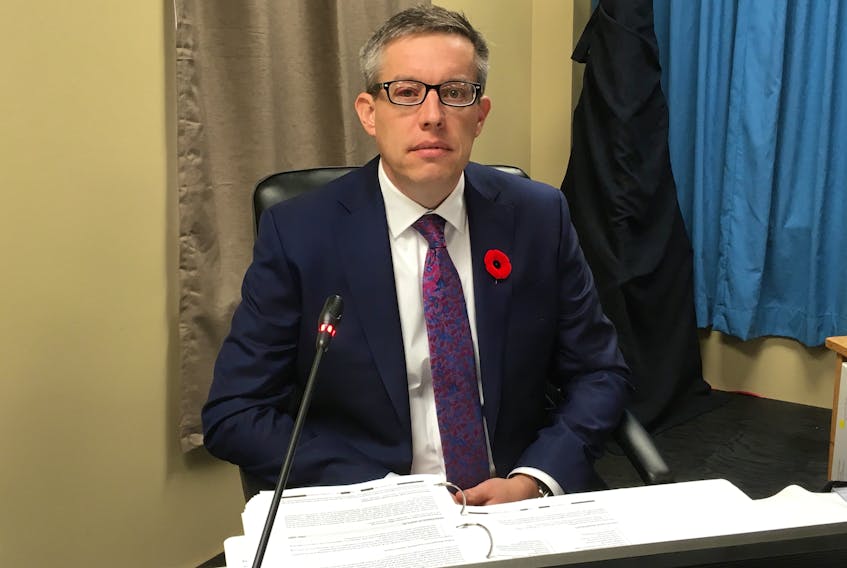The cost of the Muskrat Falls hydroelectric project has soared beyond the $6.2-billion estimate when it was sanctioned, but former deputy project manager Jason Kean says that’s not because the original, base estimate was faulty.
“I stand by the base estimate,” he said, during questioning at the Muskrat Falls Inquiry Thursday, having been grilled the day before about selective sharing of comments on his team’s work.
“I felt 100 per cent confident in that number, based upon the conditions and constraints that were defined in the ‘Basis of Estimate.’”
The “Basis of Estimate” is a detailed document of several hundred pages explaining how the project’s cost estimate was developed. It notes the base estimate includes: details on what will be built (exact scope of the project), how it will be done (including method of construction and timeline requirements), expenses including materials and labour, and performance factors such as productivity.
The $6.2-billion figure was made up of (1) the base estimate, (2) an added amount for contingency given some variations are likely to occur, and (3) an amount for price escalation (including things like inflation). The “contingency” block also included an amount for “tactical risk” — for certain uncertainties, like unsettled definition on some sub-pieces of the build.
As the inquiry has heard, the $6.2-billion price tag did not include an amount to reflect “strategic risk” on the project and a “management reserve” that could be established to cover that risk. Testimony has repeatedly referenced a report from Westney Consulting, apparently calling for $500 million to be at the ready for the project.

Lawyer Geoff Budden (the Muskrat Falls Concerned Citizens Coalition) was asking Kean about the cost estimate at sanction. He wanted to go further Thursday morning, to get Kean’s take on — beyond what has been said publicly — what might have caused the project’s cost to skyrocket during construction. But Commissioner Richard LeBlanc said that question was better suited to the second phase of the inquiry, coming in 2019.
At this point, the focus was placed on whether or not the early project estimates were on point and how risk was considered and handled.
Kean’s responses suggested many of the big answers there will have to come from various decision-makers to testify later in the inquiry hearings, including former Nalcor Energy president and CEO Ed Martin, and the project lead at the time, Gilbert Bennett.
For example, asked about the use of a “P50” probability factor on estimates —50 per cent chance of overrun and 50 per cent chance of underrun — Kean made it clear his team would run the numbers, but didn’t make the decision on what probability factors to use. Higher “P” value, like a “P75,” would mean a higher cost estimate, but also less chance of a cost overrun.
But on everything from determining the cost of concrete to the number of transmission towers needed for the Labrador-Island Link, Kean defended the capabilities of SNC-Lavalin team members, including lead estimator Paul Lemay. He said that company’s team was responsible for about 70 per cent of the base cost estimate. The rest of the estimate included some revisions by Nalcor Energy (actually removing about $260 million in expenses from an initial estimate from SNC-Lavalin in December 2011), and the addition of pieces like the Strait of Belle Isle cable crossing, where estimates were handled by Nalcor Energy and its other consultants.
“Mr. Lemay and the team he assembled were top notch,” Kean testified.
He said he did support the decision to change the arrangement with SNC-Lavalin from an engineering, procurement and construction management (EPCM) contractor to a joint “integrated management” team arrangement. The Nalcor project team and SNC-Lavalin weren’t on the same page on many fronts, for example on how work packages would be broken down for contracting.
Kean said he personally placed a lot of emphasis for his team on the idea of shared goals and values. He said they also talked about not succumbing to any optimism bias.
He remained on the project until early 2017. In January 2017, he issued a one-month notice before his departure from the project. He told the inquiry he felt there was a value change, a change in ideology and messaging from the highest levels of the corporation he didn’t agree with.
He has taken on work since as an independent consultant, including work for Westney Canada.
The inquiry is scheduled for a short break and will not have proceedings on Friday, or on Monday.
The witness schedule for next week includes: Paul Humphries, being another member of Nalcor Energy’s project team; former clerk of the executive council Robert Thompson; and Richard Westney of Westney Consulting Group.
RELATED STORIES:









